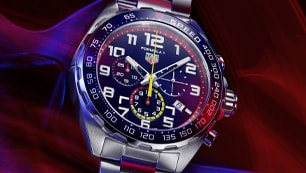HEUER AND TAG HEUER EXECUTIVE
The executive collection stood in a transitional position, in several respects. After developing three collections of dive watches from 1978 to 1984, with the Executive collection Heuer began to look up-market, with an elegant style that would be positioned as a “premium” watch or chronograph.
In this sense, the Executive would pave the way for the S/el collection, which became the Link collection and remains in the TAG Heuer catalogue to this day. All three of these collections – Executive, S/el and Link – incorporate distinctive bracelets that are defining features of the timepieces.
Of course, the Executive collection also stood at the transition from Heuer to TAG Heuer, as one of the last collections designed before the change in ownership of the company. With the Link as the Executive’s successor, we see that combining a reliable dive watch with an elegant, forward-looking design was an approach that would prove successful for TAG Heuer into the 21st century.
Heuer introduced its first range of dive watches in 1978, and by 1985 the collections included the 1000 Series, the 2000 Series and the 3000 Series. While through the development of these collections Heuer was able to move from the strictly utilitarian dive watch to watches and chronographs that had a more elegant style, in 1985 Heuer would introduce a new collection that was clearly seeking to move up-market, as evidenced by its name: the “Executive.” If the 2000 Series and 3000 Series added some style to watches that had their origins as “tool watches”, the Executive collection seems to have gone in the other direction, having its origins as an elegant watch designed for the fashion-conscious enthusiasts, while maintaining the rotating bezel and 200-meter depth rating that were the hallmarks of Heuer’s previous collections of dive watches.
Two years later, in 1987, TAG Heuer would be even more explicit about the premium positioning of its watches, when it created the S/el (Sports / Elegance) collection. Still, it was the Executive range that marked the first decisive move in this direction, with the collection being introduced under the “Heuer” name and then transitioning to the “TAG Heuer” branding, after completion of the acquisition in January 1986. The S/el would later become the “Link” collection, which remains in the TAG Heuer catalog to this day.
The pricing of watches and chronographs in the Executive collection reflected their premium positioning, going back to September 1985, the Executive stainless-steel chronograph was priced at DM 2,280 (US $820) in Germany. To put that price into context, the customer could have purchased five 1000 Series quartz dive watches for this amount, or two Lemania 5100-powered automatic chronographs. In combining features of a dive watch and a three-register chronograph, the Executive was positioned as offering the best of both worlds.
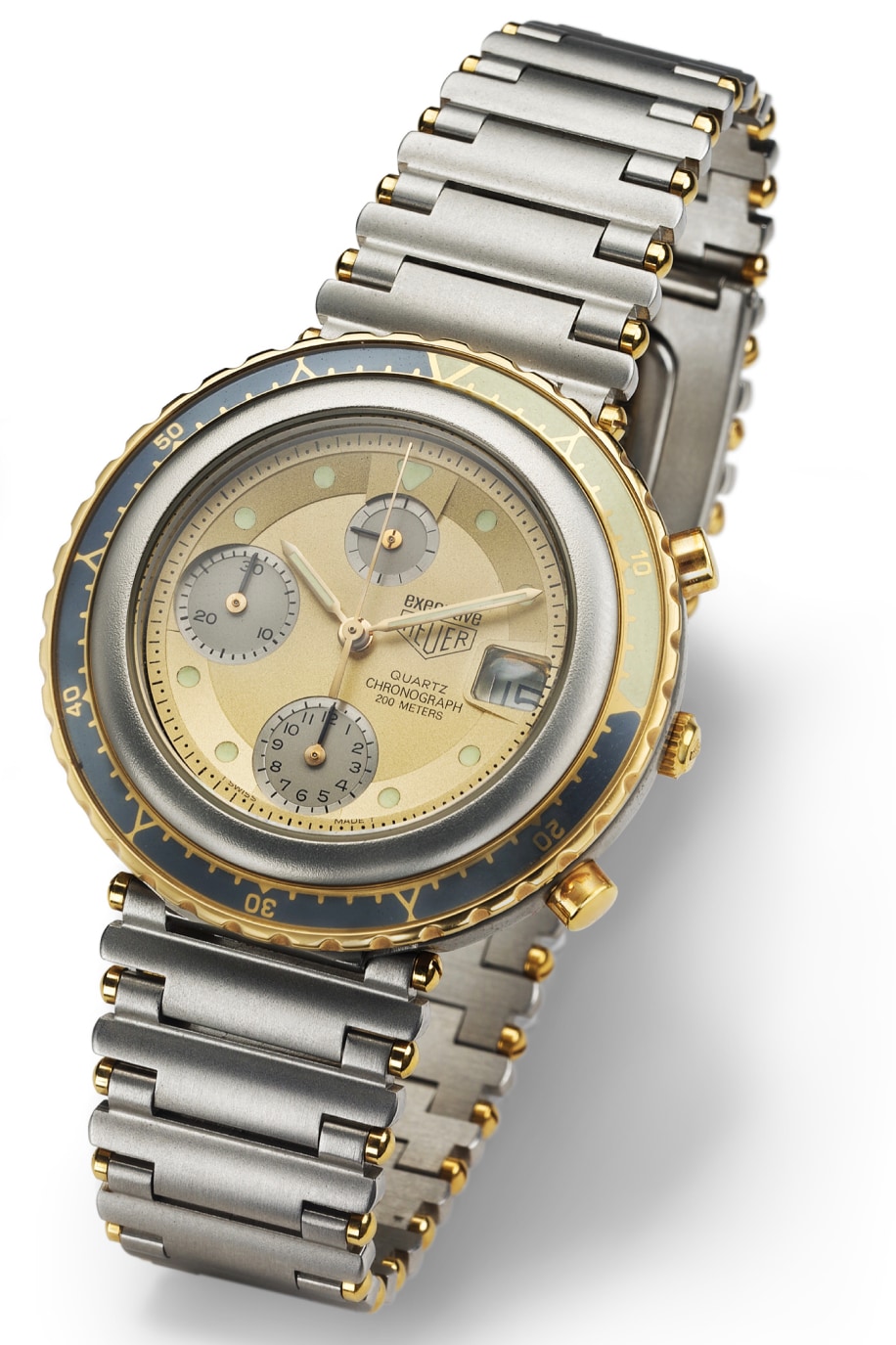
DESIGN
The Executive collection is a pure piece of 1980s design, from the “flying saucer” shape of the case, to the extensive use of “bi-metal” plated gold and steel finishing, to the elaborate “bullet” design of the bracelet, this is a collection that could only have been designed in the 1980s. While the Executive collection offered watches and chronographs, and automatic and quartz movements, in a range of finishes, every watch in the Executive collection had gold highlights, befitting of its status as the Heuer watch for Executives.
The Executive was a bold design for the time, remembering that most of the contemporary watches in the Heuer catalog were fairly conventional quartz dive watches, or models that were just beginning to move from the world of “tool” watches to the world or elegance and luxury.
CASE
The case has a unusual profile, attaching to the unique bracelet by means of wide central lugs, rather than by two traditional lugs at the sides of the case. The case depth varied significantly depending on whether it was housing the bulkier modular quartz or mechanical chronograph movement, or the slimmer quartz movement for the three-hand watch. With their thinner cases, the quartz powered watches evoked the elegance that TAG Heuer would emphasize in the late 1980s, and moving forward.
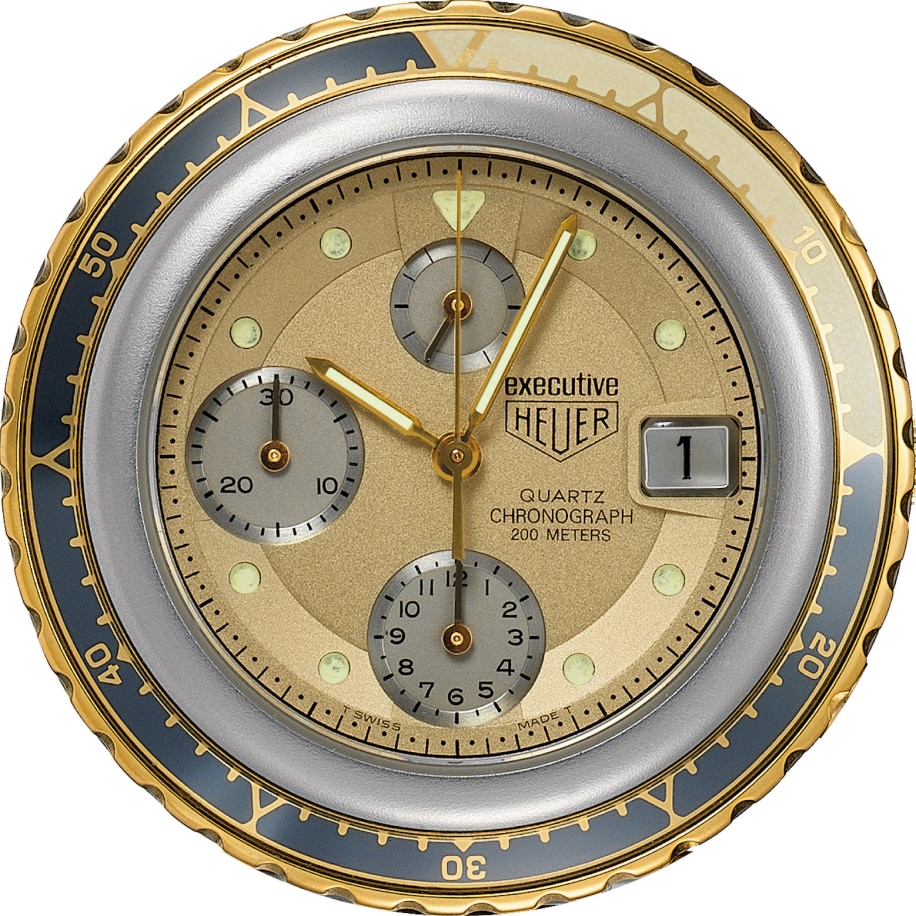
DIAL & BEZEL
The dial on the Executive is quite detailed, with three distinct elements: the outer edge of the is marked for minutes / seconds, with hash marks for 1/5 second intervals of the chronograph; the banked second element hosts the luminous hour plots; and the center section of the dial has a matte champagne or black finish. This terraced approach gives the dials of the Executive watches and chronographs considerable depth, a sense emphasized further on the chronograph by the deep-set date. Consistent with the elegant style of the watch, the cyclops for the date display is set inside the crystal, rather on the top surface, as typically seen on a dive watch.
Cutting across the dial on the three-hand watch model are four raised trapezium sections, at 12, 3, 6 and 9 o’clock, while on the chronograph, we have three sub-dials at 12, 6 and 9 o’clock. This sub-dial layout was typical of the era. Whereas the 1960s and early 70s was dominated by traditional 3-9 or 3-6-9 chronograph layouts, the 1970s saw the introduction of two new, sharply priced chronograph movements with 6-9-12 layouts: the Valjoux 7750 and the Lemania 5100. As these watches became popular, so too did the “new” dial layout, a clear step forward from the style of the chronographs that dominated the Heuer catalogues from the 1930s through the 1960s. The Executive chronograph was powered by the LWO 283 modular calibre, which was the main mechanical chronograph movement used across the Heuer range in the mid-1980s.
Different types of hands are used on the three-hand watch and chronograph models. The chronograph features sword shaped hour and minute hands with a needle central chronograph hand, while the three-hand watch has a Mercedes-style hour hand and a lollipop sweeping seconds hand, in the traditional style of dive watches.
In an approach that is unique to the Executive, the dial doesn’t extend to meet the bezel, with a large colored large flange (sandblasted steel, gold-plated or black coated) sitting between the two. The bezel of the Executive is one of the innovative features of the collection as TAG Heuer highlighted in the catalogues of the day:
The turning bezel, a vital function in any professional watch, is the original and innovative element in the new TAG-Heuer Executive collection. The new bezel was specially developed by TAG-Heuer and pivots around the middle of the watch”. This internationally patented system gives TAG-Heuer Executive watches their avant-garde shape and greatly reduces the thickness of this professional watch.
Consistent with the requirements of a dive watch, the bezel is marked in minutes, with numerals at the 10-20-30 marks, etc. The notched bezel is a one-piece construction (rather than a bezel insert fitting inside a turning bezel), with Series 2 models featuring a mineral glass covering, which would also use an updated, simpler flat dial.
BRACELET
The chain bracelet evokes the style of the 1980s, with large pins (gold-plated or PVD depending on the model), which allow links to be easily removed or added. Rather than being discreetly concealed, these pins are instead a feature of the bracelet design. With its wide, central lug, the case of the Executive was specifically designed to mate with this bracelet, with it being impossible to use a traditional leather strap on the Executive.
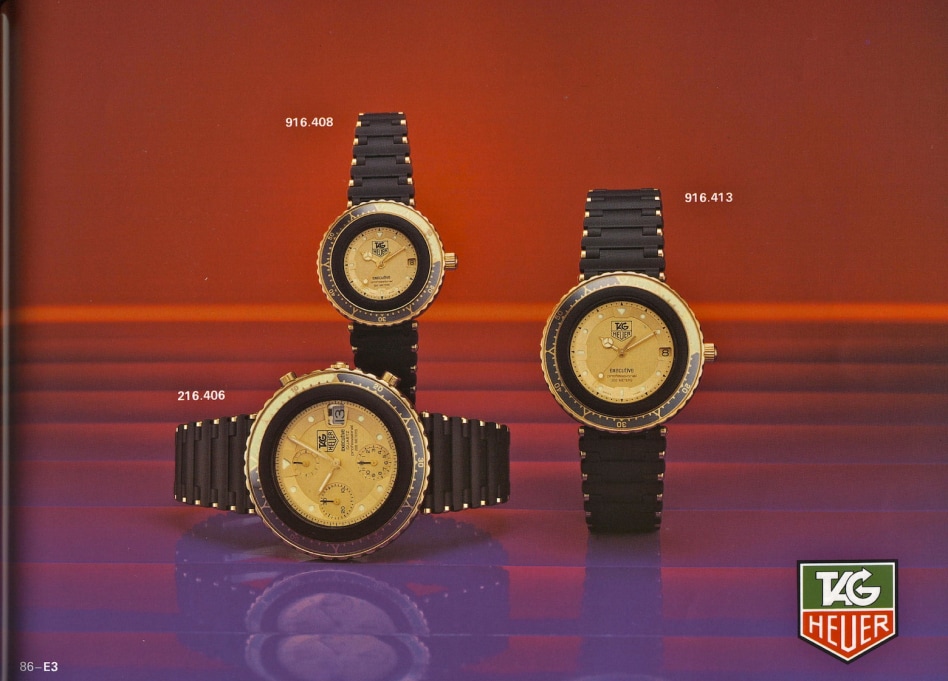
SERIES 1: HEUER AND TAG HEUER EXECUTIVE RANGE
The Heuer Executive collection was relatively straight forward, with nine models available at launch- three different designs, each available in three sizes:
- xxx.x06: Mens
- xxx.x13: Mid-size
- xxx.x08: Ladies
Note that the men’s size was only available as a chronograph, featuring either the LWO 283 mechanical chronograph movement, or the Calibre 185 quartz chronograph movement. All other sizes are quartz 3-hand watches only.
The Series 1 watches were all available with either a Heuer or TAG Heuer logo, and apart from this change in branding, are otherwise almost identical.
STEEL CASE/ CHAMPAGNE DIAL
The first model features a sandblasted stainless steel case, with a matching stainless steel and gold-plated bracelet. The dial has a champagne finish with matching hands and contrasting silver sub dials on the chronograph.
As with all Series 1 watches, the 0-to-15 minute section on the integrated bezel has a “tritium zone” that lights up in the dark. This colour combination was available as a Heuer in the 1985 Catalogue and continued on as a TAG Heuer model.
BLACK PVD CASE/ CHAMPAGNE DIAL
The second colour option had the same coloured dial (without a contrasting color for the chronograph registers) but this time with a black-coated case and bracelet. As with all models, the inner flange matches the colour of the case, in this instance being black coated. The strong contrast between the gold dial and the black flange gives the appearance of the dial floating inside the case.
GOLD CASE/ BLACK DIAL
The last colour option was the all-gold model, which offered a black dial with gold-plated case and bracelet. The bracelet pins on these watches are also black.
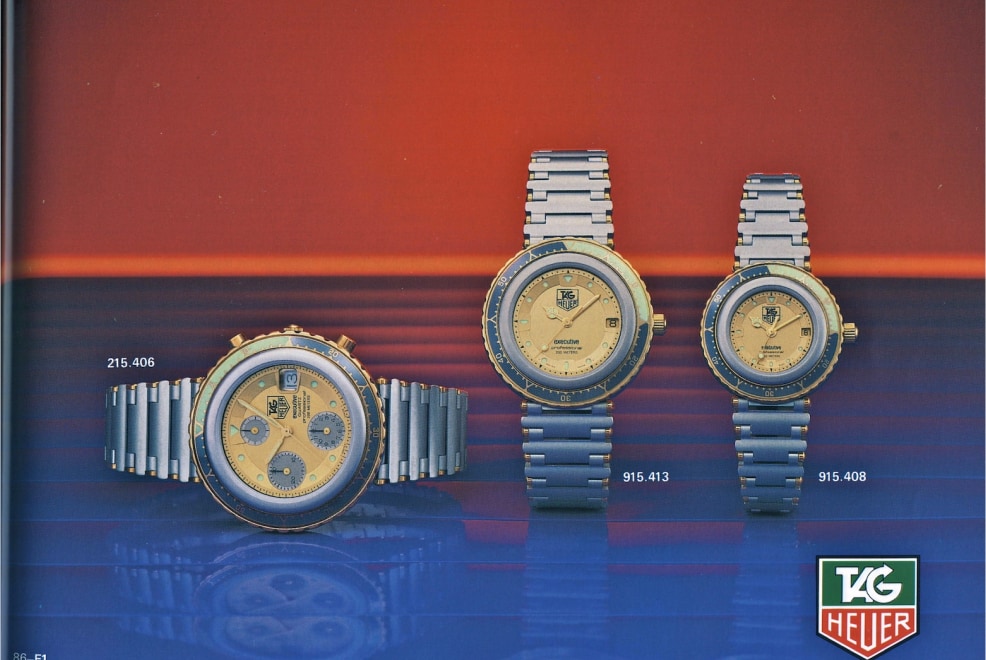
SERIES 2: TAG HEUER EXECUTIVE RANGE
Joining the Executive collection a year later, in 1986, were three color options that were only available as TAG Heuer signed models. Each of these watches has a simplified dial, with the Skipper version gaining a bespoke look of its own. Unlike the Heuer Executive models available from launch, each of the newer watches was only available in two sizes, with no chronograph option.
STEEL CASE/ CREAM DIAL
The first of these Series 2 watches has a cream dial with gold-plated hands and inner flange. As noted earlier, these dials are far simpler than those on the Series 1 watches, with simple circular hour markers with a triangle-shaped marker as 12 o’clock and rectangular markers at 6 and 9 o’clock.
The bezel on these models is a little different: a chromed blue base covered by mineral glass with gold-plated lettering and there is no “tritium zone” on these bezels.
STEEL CASE/ BLUE DIAL
The next option is essentially the same as the cream dial watch, but this time with a blue dial.
EXECUTIVE SKIPPER
The most unusual watch in the Executive collection was the Executive “Skipper”, a model obviously targeting the sailing enthusiasts. This model is not always referred to as a “Skipper”, but we do see this branding in certain TAG Heuer catalogues.
The most distinctive element of the Executive Skipper is the bezel, which features a series of flags, nine single flags and three double flags. These flags are simply the maritime numeral pennants, which count from 1 to12, with two flags used for double-digit numbers (10, 11 and 12).
EXECUTIVE SKIPPER SPECIAL EDITION - “FORMULE TAG”
There is also a special edition Executive Skipper, ref. 915.813, which features a boat with a single white sail and a blue spinnaker and the word “TAG” in place of the usual “Executive” and “Professional” text.
This logo likely represents Formule TAG, a special catamaran backed by TAG (TAG Heuer’s owner from 1986) with an interesting history.
FORMULE TAG
Formule TAG was an innovative catamaran project, begun in 1982 as the brainchild of Canadian skipper Mike Birch with support from Techniques d’Avant Garde (TAG).
The catamaran had twin 80-foot carbon fiber/Kevlar hulls built by Canadair in Montreal using aerospace technology, similar to the ideas being pursued by the TAG-owned McLaren in Formula 1, which developed the first carbon-fibre-composite monocoque in conjunction with Hercules Aerospace for the 1981 McLaren MP4/1.
Formule TAG was the first multihull, and the first racing sailboat, to beat the 500-mile-a-day barrier, clocking 517 miles in 24 hours during the 1984 transatlantic Quebec-Saint-Malo race. This was one of the most innovative catamarans ever built, racing under several names and today is known as the Energy Observer, the first hydrogen-powered/zero emissions vessel.
The boat raced in TAG colours from its launch in 1983 through to 1985 and then raced during the 1986 season in TAG Heuer colours, the same year as the two special edition TAG Heuers Executive watches.





